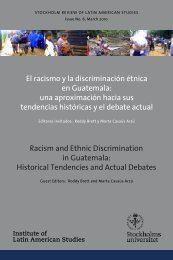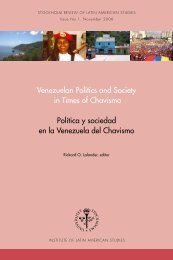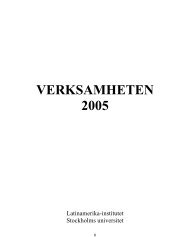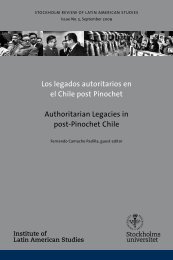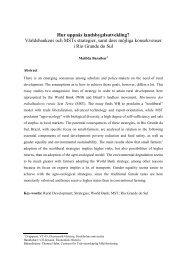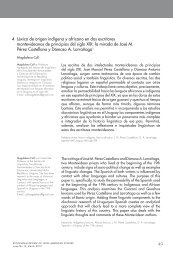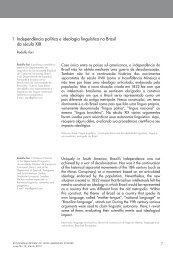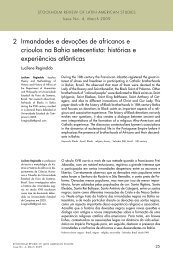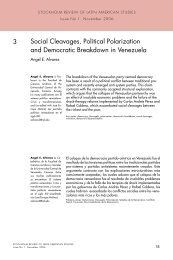Papers - Conference 2009 - Institute of Latin American Studies
Papers - Conference 2009 - Institute of Latin American Studies
Papers - Conference 2009 - Institute of Latin American Studies
You also want an ePaper? Increase the reach of your titles
YUMPU automatically turns print PDFs into web optimized ePapers that Google loves.
(HYLTON, 2006, 6). The phenomenon involves all <strong>of</strong> Colombia’s territory andnearly ninety percent <strong>of</strong> the country’s municipalities expel or receive population.These regions are highly heterogeneous in a cultural and ethnic sense, but arelinked by low levels <strong>of</strong> formal education and limited rural environment workopportunities.In 2006, Acción Social, the <strong>of</strong>ficial entity which co-ordinates the National Systemfor Assistance to displaced people, estimated the total number <strong>of</strong> internallydisplaced as less than two million. At the same time, the Consultoría para losDerechos humanos y el Desplazamiento –CODHES- NGO, presented a figure <strong>of</strong>almost four million. (CODHES, 2006, 15). This disparity in numbers is not onlydue to different methodologies in data collection and problems <strong>of</strong> reliability orpolitical bias in data interpretation, but also reflects different perceptions as towhen the crisis began. Official figures use 1997 as a starting point—this was theyear when public policy first <strong>of</strong>ficially recognised the existence <strong>of</strong> a“displacement problem”, whereas CODHES takes 1985 as the conflict's beginningand uses the figures provided by the Catholic Church, long-established in theterritory.Therefore, given the enormous complexity <strong>of</strong> population movements and thetendency to under-register displaced persons, the real number <strong>of</strong> displaced peoplewill probably be closer to the non-<strong>of</strong>ficial figures. The state policy mighteffectively mitigate the impact <strong>of</strong> displacement, but while the Colombiangovernment perceives displacement as a phenomenon on the decline especiallythanks to the Democratic Security policy 3 adopted, Human Rights NGOs continueto vie for the overlooked victims <strong>of</strong> displacement.3Politica de Seguridad Democratica - Democratic security policy- refers to a Colombian security policy implementedduring the administration <strong>of</strong> President Álvaro Uribe (2002-2010). It was unveiled in June 2003. It has been stated thatthis policy seeks to achieve the following objectives, among others: Consolidate State control throughout Colombia todeny sanctuary to terrorists and perpetrators <strong>of</strong> violence, protect the population through the increase <strong>of</strong> State presenceand a reduction in violence, destroy the illegal drug trade in Colombia to eliminate the revenues which finance terrorismand generate corruption and crime, transparently and efficiently manage resources as a means to reform and improvethe performance <strong>of</strong> government.10



